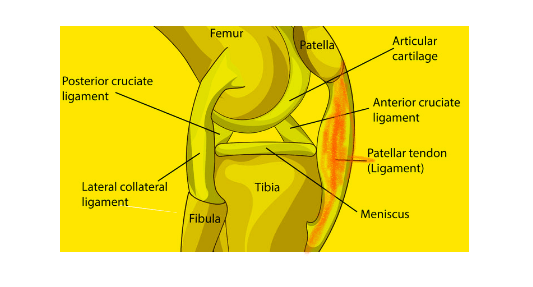Quick Overview
The patellar tendon is a thick, fibrous band of tissue that connects the patella (kneecap) to the tibial tuberosity (a bony prominence at the top of the shinbone). It is one of the most powerful tendons in the body and plays an important role in extending the knee joint.

Table of Contents
Patellar Tendon Anatomy
The Patellar Tendon is a continuation of the quadriceps muscle group, which is responsible for straightening the knee. It inserts into the tibial tuberosity, a bony prominence on the tibia, providing the necessary leverage for knee extension.
Location of the Patellar Tendon
The Patellar Tendon is centrally located in the front of the knee joint, and it forms a critical component of the knee’s extensor mechanism.
Patellar Tendinitis
Patellar tendinitis, also known as jumper’s knee, is an inflammation of the patellar tendon. It is a common overuse injury that can occur in athletes who participate in sports such as basketball, volleyball, and running. Patellar tendinitis can also occur in people who perform repetitive activities such as squatting and jumping.
Causes
The most common cause of patellar tendinitis is overuse of the patellar tendon. This can occur in athletes who participate in sports such as basketball, volleyball, and running. Patellar tendinitis can also occur in people who perform repetitive activities such as squatting and jumping. Other possible causes of patellar tendinitis include;
- Tightness in the quadriceps muscles (the muscles at the front of the thigh)
- Weakness in the hamstring muscles (the muscles at the back of the thigh)
- Sudden increase in activity level
- Improper training techniques
- Flat feet or high arches
- Wearing shoes that do not fit properly
Read also Anterior Talofibular Ligament (ATFL) and Glenohumeral Ligaments
Sign and Symptoms
The most common sign and symptom of patellar tendinitis is pain in the front of the knee, just below the kneecap. The pain is typically worse with activity, such as running, jumping, and squatting. Other symptoms of patellar tendinitis include:
- Swelling and tenderness in the front of the knee
- Crepitus (a popping or grinding sensation) in the front of the knee
- Difficulty extending the knee
- Patellar Tendonitis Diagnosis
Diagnosis
Patellar tendinitis is typically diagnosed based on a physical examination and medical history. Imaging tests, such as an X-ray or MRI, may be ordered to confirm the diagnosis and rule out other causes of knee pain.
Treatment
Treatment for patellar tendinitis typically includes rest, ice, compression, and elevation (RICE). Physical therapy may also be recommended to help strengthen the quadriceps and hamstring muscles and improve range of motion. In some cases, nonsteroidal anti-inflammatory drugs (NSAIDs) or corticosteroid injections may be prescribed to help reduce pain and inflammation.
If conservative treatment is not effective, surgery may be considered to remove the inflamed portion of the patellar tendon. However, surgery is rarely necessary for patellar tendinitis.
Prevention
The best way to prevent patellar tendinitis is to avoid overuse of the patellar tendon. This can be done by gradually increasing the intensity and duration of your workouts, and by taking breaks from repetitive activities. Other things you can do to help prevent patellar tendinitis include:
- Warming up before exercise and cooling down afterwards
- Stretching your quadriceps and hamstring muscles regularly
- Maintaining a healthy weight
- Wearing shoes that fit properly
If you experience any pain in your knee, it is important to see a doctor to get a diagnosis and treatment plan.
Questions
Q: What is patellar tendinitis?
Patellar tendinitis, also known as jumper’s knee, is an inflammation of the patellar tendon, which connects the kneecap to the shinbone. It is a common overuse injury, especially in athletes.
Q: What are the symptoms of patellar tendinitis?
The most common symptoms of patellar tendinitis are pain and tenderness in the front of the knee, just below the kneecap. The pain is typically worse with activity, such as running, jumping, and squatting. Other symptoms may include swelling, crepitus (a popping or grinding sensation), and difficulty extending the knee.
Q: What causes patellar tendinitis?
Patellar tendinitis is most commonly caused by overuse of the patellar tendon. This can occur in athletes who participate in sports such as basketball, volleyball, and running. It can also occur in people who perform repetitive activities such as squatting and jumping. Other possible causes include tightness in the quadriceps muscles, weakness in the hamstring muscles, sudden increase in activity level, improper training techniques, flat feet or high arches, and wearing shoes that do not fit properly.
Q: How is patellar tendonitis treated?
Treatment for patellar tendinitis typically includes rest, ice, compression, and elevation (RICE). Physical therapy may also be recommended to help strengthen the quadriceps and hamstring muscles and improve range of motion. In some cases, nonsteroidal anti-inflammatory drugs (NSAIDs) or corticosteroid injections may be prescribed to help reduce pain and inflammation. Surgery is rarely necessary.
Q: How can I prevent patellar tendinitis?
The best way to prevent patellar tendinitis is to avoid overuse of the patellar tendon. This can be done by gradually increasing the intensity and duration of your workouts, and by taking breaks from repetitive activities. Other things you can do to help prevent patellar tendinitis include: warming up before exercise and cooling down afterwards, stretching your quadriceps and hamstring muscles regularly, maintaining a healthy weight, and wearing shoes that fit properly.
